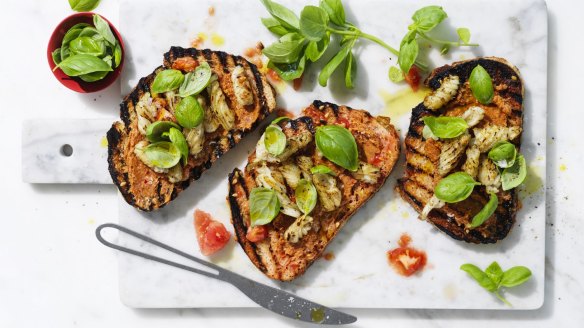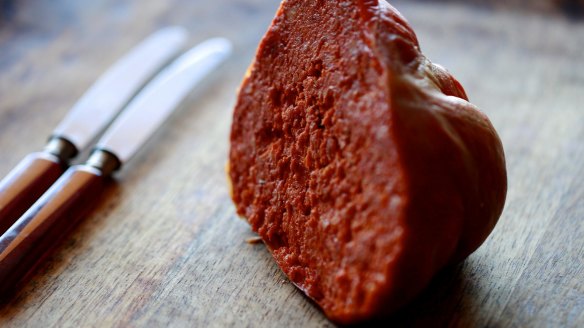'Nduja: Everything you need to know

What is it?
A fermented sausage, originally from Calabria in Italy, that has a texture like sticky pâté and a spicy kick on it like an angry mule. Pronounced en-doo-ya, it is a mixture of pork fat – up to 70 per cent – pork, salt, spices, culture and chilli peppers, which are ground together until smooth, wet, unctuous and deep red. It is stuffed into large-sized natural animal skins and slowly fermented and air-dried. The lactic acid bacteria in the culture ferments the sugars in the mix, making the 'nduja acidic enough to keep it safe from bad bugs. The name 'nduja, or nduja, is Calabrian slang and is said to derive from the word for the smoked French sausage andouille, introduced by the French House of Anjou in the 1200s.

Why do we love it?
An exotic arranged marriage of fat, salt, chilli heat and lactic acid fermentation produces a fermented but soft salume. It's made in Australia by some outstanding butchers, who use imported Calabrian red pepper paste and chillies for that burst of capsaicin heat. This is ameliorated by the smoothness of the paste, pleasant saltiness and the tangy lactic acid finish that is shadowed by a powerful umami note. In other words – it hits all the sensory notes.
Who uses it?
Robert De Palma, from De Palma Salume in Sydney, set out to make an easily spreadable 'nduja in a small cacciatore salami-sized casing. "I eat [it] on freshly toasted bruschetta and let the heat of the bread melt the fat," says the Padstow salumist. "I stir it through hot pasta, and put a whole sausage on a salume board. I have even been known to eat it straight from the sausage with a spoon." In Melbourne, the chefs at SPQR Pizzeria put it on pizza with prawns, while David Lakhi from Little Black Pig and Sons in Heidelberg whips 'nduja with olive oil and serves this with whipped buffalo ricotta and piadina. The Indian-born chef was trained by an 86-year-old Italian nonna, who taught him to make a sauce of cuttlefish, cacciatore salami and 'nduja slow-cooked with tomato paste and chicken stock and served with paccheri pasta and sharp mustard greens.
How do you use it?
Try it on hot toasted bread or pimp the bread with tomato and grilled squid. Follow Neil Perry's recipe and make your own piadine and fill them with slow-roasted tomatoes and 'nduja. It is not a costly salume, so if you're 'nduja-curious, experiment with it in savoury dishes. Use it like a spicy stock cube, adding several tablespoons to an amatriciana pasta sauce. For a burger with a spicy zing, spread a thin layer of 'nduja over your toasted buns before you add the other ingredients. Add small pieces of 'nduja to hot, freshly cooked pasta with a little olive oil and let the pasta melt the paste into a sauce. Or mix it with a little honeycomb, spread over crackers and match with a big shiraz.
Where do you get it?
Delicatessens, Italian butchers and specialty butchers. Buy De Palma 'nduja from 188 Certified, Double Bay; Cheese Etc, Bowral; or Raineri's Continental Delicatessen, Five Dock. Also look out for Quattro Stelle's 'nduja at its store in Belmore. In Melbourne, head to Meatsmith butchers and to the delis at Queen Victoria, Prahran, South Melbourne and Camberwell markets. Look out for Italian-made spreadable 'nduja, packed in jars, such as L'artigiano della Nduja.
Suggest an ingredient via email to brainfood@richardcornish.com.au or tweet to @foodcornish
Appears in these collections
- More:
- Food
- Brain food
